Why does the toilet tank sweat: causes of fogging and how to eliminate them
Modern toilets are comfortable and aesthetically pleasing, and the inside smells pleasantly of scented products.To make it comfortable to be in the bathroom, it requires special care. Do you agree? The room must be constantly cleaned and problems, including the formation of condensation, must be eliminated in a timely manner.
If water constantly flows down the outer surface of the tank, an unpleasant odor appears in the apartment over time, and the plumbing fixture loses its attractive appearance. To get rid of condensation and avoid negative consequences, you need to find out why the toilet tank in the bathroom is sweating.
We will tell you how to independently figure out and eliminate the cause of tank leakage. Useful recommendations and expert advice are presented in our material. For clarity, it is accompanied by thematic photographs and videos. This will help you get to the root of the problem faster.
The content of the article:
Causes of condensation
If drops of water are constantly forming on the tank of your toilet, the first thing you need to do is identify the cause of their appearance.
A common cause of condensation in the toilet is high humidity in the room. To normalize this indicator, it is necessary to identify the cause of the increase in humidity.
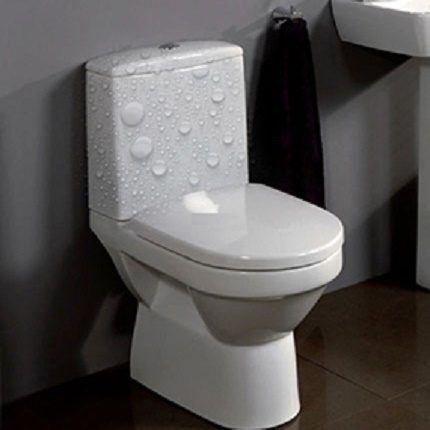
Increased humidity in the bathroom can be caused by various reasons:
- The apartment or house contains a large aquarium or a lot of vegetation that requires constant watering. In these cases, the problem can be solved by installing dehumidifiers.
- Washing and drying clothes is carried out in significant volumes, which is more often observed in large families. It is recommended to hang washed laundry on the balcony or in the yard.
- Moisture can settle on the cistern and bathroom wall surfaces due to leaking sewer pipes or connections. It is urgent to identify and fix the plumbing problem.
- Insufficient ventilation does not fulfill its functions, as a result of which the room cannot dry quickly.
- Due to a breakdown of the shut-off valves, cold water may constantly flow in the tank, which does not have time to reach room temperature and causes condensation to appear on the walls of the plumbing.
Condensation forms on the tank of plumbing equipment due to the fact that the air temperature in the room differs from the temperature of the water in the toilet by about 15 degrees. Therefore, the outer surface of the tank begins to fog up.
Since water enters the toilet from a water supply system located underground or outdoors, its temperature depends on external weather conditions.
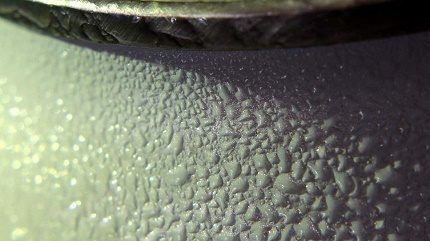
The laws of physics will help identify the original source of the malfunction.As you know, warm air currents, in contact with cold water (in the drain tank), are converted into droplets of moisture. The process of condensation formation on the tank can be stopped by studying in more detail the possible causes of this phenomenon and ways to eliminate them.
The consequences of condensation on the drain tank
If, when droplets of water appear on the toilet cistern, urgent measures are not taken, then a puddle of water will appear under the plumbing equipment. unpleasant smell.
In the future this will lead to the following consequences:
- increasing humidity in the bathroom;
- the occurrence of mold and fungi;
- the appearance of an unpleasant damp smell;
- plumbing will be subject to corrosion, causing it to rust and lose its attractive appearance;
- formation of rust and corrosion, gradual destruction of the sewer pipeline;
- the tank and its bolts will begin to rust, become unusable and require replacement;
- rotting of floor and ceiling materials, which can cause partial destruction of the ceilings.
The problem of condensation in the bathroom, at first glance, may seem insignificant, but if this phenomenon is ignored for a long time, serious consequences can occur.
Dampness, black mold, unpleasant odor, discomfort and complaints from neighbors living below about the appearance of stains on the ceiling are the results of continuous condensation on the surface of your toilet cistern.

In addition to pipe corrosion, there is a more serious problem.If you ignore the formation of puddles on the floor for a long time, then under the influence of moisture a gradual process of rotting of the floor materials occurs.
As a result, water seeps below, provoking processes of rotting of materials on the ceiling of neighbors living below. At first, damp stains will appear on the ceiling. In the future, the destruction of the ceiling between apartments is possible.
If your toilet cistern is sweating, you need to take drastic measures immediately. Methods for dealing with unaesthetic condensation depend on the reasons for its formation.
Excessive water consumption in the bathroom
Sometimes the toilet tank fogs up due to excessive water consumption.In bathrooms where the toilet is flushed frequently, more cold liquid enters the tank, which increases the likelihood of condensation forming.
To solve this problem you need adjust the fittings, reducing the amount of water supplied to the tank. In a large family, the toilet is used frequently, so it is better to buy a toilet with an adjustable or stepped flush.
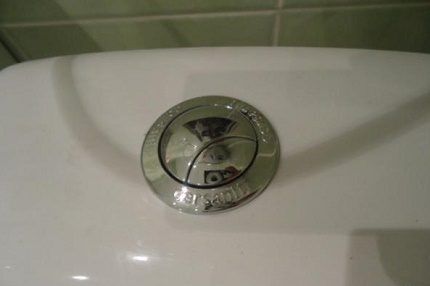
Minimizing flushing can be done using toilets equipped with a cistern with a two-button flush mechanism. If one button is used, 5 liters of water flows out of the cistern, and if the other button is used, approximately 7 liters.
Some models have tanks with aquastop drain. The lid has one control button: the first time you press it, the water begins to drain, and the second time this process stops.
Insufficient toilet ventilation
Sometimes installing a ventilation device or an additional fresh air supply is enough to say goodbye to the problem forever.
How to check the ventilation system?
If your toilet cistern is sweating, you urgently need to check the integrity and serviceability of the ventilation system in the bathroom. You need to bring paper, a candle or a lighter to the ventilation grille.
The system works fine as long as the paper sticks and the flame burns evenly. If paper falls or the flame goes out, then urgent measures must be taken to restore ventilation.
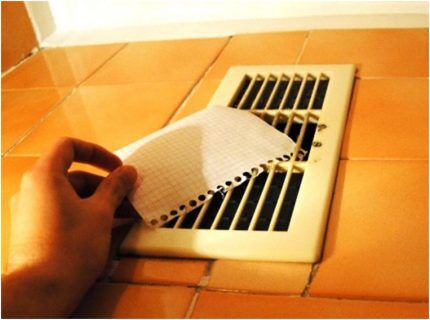
You can solve the problem of constant condensation in the following ways:
- Cleaning ventilation ducts.
- Installing an additional fan on the exhaust duct.
An effective option for getting rid of exhaust air and getting a clean supply is to leave a gap 2 cm high.
An excellent solution is to install a multifunctional door valve that allows air from outside and at the same time blocks unpleasant odors, preventing them from spreading throughout the living space.

Problematic ventilation system may be the reason why the tank is sweating. But most owners of living space, trying to make the room look better, simply cover the ventilation holes with finishing. There is no need to do this; a good option is to buy beautiful decorative grilles designed specifically for this purpose.
Installing a fan in the bathroom
In order to stop the process of fogging of the tank, walls and floor in the bathroom, try installing forced ventilation in the room.
Sometimes a simple fan, which is mounted in the vent and starts to function when the light in the toilet is turned on, can eliminate the formation of condensation on surfaces. If this does not solve the problem, you should call specialists to install more effective ventilation systems.
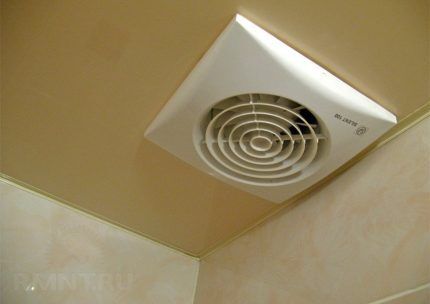
If the toilet cistern is sweating, you should first check the ventilation.Some owners, in order to “cultivate” the bathroom, completely seal up the existing ventilation holes.
Consumers should pay attention to the decorative grille, which will save you from problems with ventilation and will look aesthetically pleasing. One way to solve the problem is to leave the door to the toilet ajar.
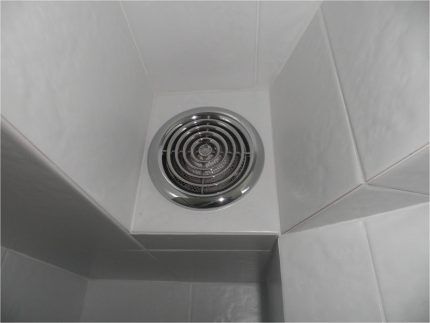
Installation of forced ventilation is often used in combined bathrooms, which are characterized by the appearance of condensation on the toilet, tiles, ceiling, mirrors and other surfaces. In this case, it is better to install a professional ventilation system.
The power of the equipment must correspond to the operating conditions, then droplets of condensation will stop appearing.
Installation of an axial fan in the exhaust hole located in the bathroom is carried out in the following order:
To check whether the ventilation in a plumbing unit is working properly, you need to do a second check: light a lighter (candle, match), bring it to the hole and look at the light.
If it goes out or is drawn into the ventilation duct, then the ventilation system is functioning well. If the position of the flame remains the same or the deviation is small, you need to consider another method.
Ways to deal with condensation
The reasons for excessive moisture on the toilet cistern were described a little higher. Now let's look at the simplest ways to eliminate them.
If condensation on the walls of the flush tank occurs only in the summer, take the following measures:
Method #1. Repair of shut-off valves
A common cause of the formation of wet condensation on the outer surface of the tank is the breakdown of shut-off valves and float mechanism. Due to a faulty mechanism, cold water from the sewer pipes flows continuously into the tank without having time to settle.
As a result of the movement of cold water flows, condensation appears. If there is a meter, the owner of the apartment will have to pay for the leakage.
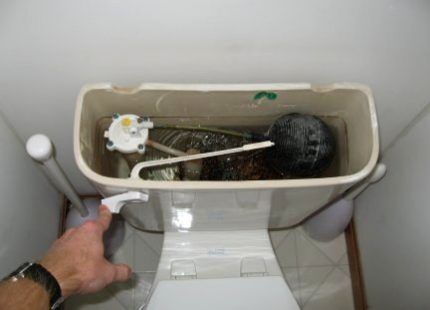
Most modern plumbing models do not require “local” repairs, so manufacturers do not produce small spare parts for them. In the event of a breakdown, you will have to purchase a set of shut-off valves.
If you can identify faulty structural elements and make repairs at the site of the breakdown, you will be able to reduce excessive cold water consumption, which is important for housing with a meter.
You can solve the problem without plumbing skills with the help of a specialist. If you are familiar with the principle of operation of the drainage system, then you can carry out the repair yourself, while saving on calling specialists.
Depending on the toilet model, there are two ways to solve the problem - replacing the shut-off valves or local repairs of failed structural parts.
Method #2. Repairing water leaks
Condensation can appear due to various factors, one of which is water leakage. More often, the breakdown is caused by malfunctions of parts of the fittings and is observed when filling the container with cold water.
Condensation forms at any water pressure, but the degree of fogging of the tank depends on the power of the pressure. To fix the problem, you need to adjust the water drainage system or replace faulty parts.

If water flows freely into the toilet in a thin stream, its volume in the flush tank must be constantly replenished. This explains the appearance of condensation on the surface of the tank, walls and floor, as well as high water consumption.
In some cases, replacing the worn rubber siphon membrane will solve the problem. The replacement process goes like this:
- All water is drained from the tank;
- the lever is fixed in such a position that the drain hole is closed with a valve and water does not flow into the device;
- the siphon is disassembled by separating the part from the lever;
- take out the worn out membrane and replace it with a new one.
At the end, the siphon is put in place and a test drain is made.

If the cause of the toilet leak is a faulty float, you must perform the following steps:
- remove the float from the drain tank;
- pour the water out of it and let it dry;
- glue the hole through which water flows;
- install the float in place.
The best option is to buy a new float, since a repaired part will not last long. The problem can be easily solved if the water leakage is due to an incorrect placement of the float.
To fix the problem, you need to open the toilet tank and set the lever to its normal operating position.
Method #3.Installing a double wall cistern
Manufacturers of plumbing equipment have developed innovative toilet models equipped with a cistern with a double-wall system. The design of the toilet is distinguished by the presence of double walls in the tank for draining water.
In this case, the additional plastic container located inside does not come into contact with the walls of the main ceramic bowl, forming an air cushion. As a result, the water has a constant room temperature.
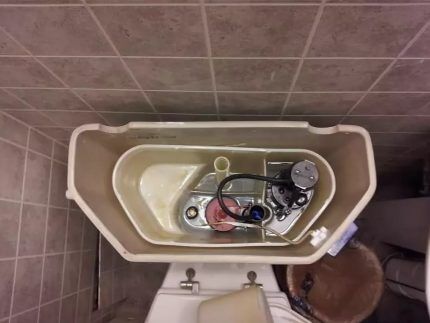
A new design solution from plumbing developers makes it easy to solve the problem of fogging in the toilet tank. For most buyers, these models are unaffordable - they are several times higher than the cost of standard toilets. Therefore, some home craftsmen independently make double walls in the drain tank.
It is better to treat the inner walls of the bowl with liquid waterproofing materials, for example, mastic. Bonded materials are less effective and durable.
Method #4. Thermal insulation of the cistern
You can insulate the walls of the drain tank from the action of cold water using heat-insulating materials that are firmly glued inside the tank.
In the process of installing thermal insulation on a tank or pipes, special insulating materials and improvised means are used. Neoprene or expanded polystyrene foam is often used as insulation.
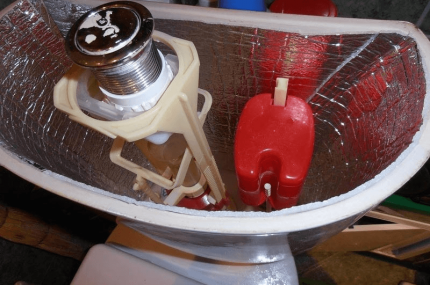
Thermal insulation prevents the walls of the drainage device from coming into contact with cold water.
To obtain the required result, you must perform a number of actions:
- Turn off the water supply to the plumbing fixture.
- Disconnect the hose that supplies water to the drainage system.
- Remove the water drain tank.
- Disassemble all the elements located in the middle of the drain bowl.
- Wash and dry the container.
- Cut out the liner from the heat-insulating material (spread it on a flat surface, place the tank on it, circle the bottom along the perimeter and cut off the workpiece).
- Place the resulting workpiece inside the container and press tightly.
- Measure the internal height of the walls (from the liner to the top edge of the tank).
- Measure the perimeter of the walls, adding an allowance of 100 mm.
- Place the pattern in the middle of the container. Since the joint will overlap, you need to press the workpiece against the wall and make a through cut.
- Get the blanks for further assembly.
- Apply sealant to the bottom near the holes for the fittings.
- Put the bottom in its place.
- Apply glue to the sides of the container, then place the inner liner.
- Use silicone to fill the vertical joint.
- Seal the joint between the walls and the bottom with sealant.
- After 24 hours, you can make holes for the reinforcement and apply sealant to the edges.
- Install all elements in place.
It should be borne in mind that thermal insulation of the toilet cistern is not always able to solve the problem of fogging of the plumbing fixture
Other ways to deal with condensation
Another solution to the current problem of high humidity in the bathroom is to purchase a dehumidifier.
The principle of operation of the electrical appliance: a powerful fan directs a flow of moist air into a special cooling chamber, in which the process of condensation of moisture occurs and its separation into a special container. Then the dried air is heated and successfully returned to the bathroom.

In addition to the above methods of combating education condensation on the tank and other surfaces, experts suggest considering the possibility of installing heated towel rails.
Another simple but effective method of eliminating the process of moisture formation in the bathroom is to increase the temperature of the water that constantly enters the home toilet system.
To begin with, it is recommended to try to properly insulate the sewer pipes. If this technique does not help, then you can install a special boiler designed to heat the water in the drain tank to room temperature.
If you are unable to identify why the toilet tank is constantly sweating and remove the condensation yourself, you need to contact professional plumbers.
Conclusions and useful video on the topic
Video #1. Do-it-yourself thermal insulation of a toilet cistern:
Video #2. Installation and installation of a double tank:
Video #3. Reasons for the formation of condensation on the tank and cold water pipes and ways to eliminate it:
We have given possible reasons for the formation of condensation in the bathroom and listed effective ways to solve this problem.If you do not have the opportunity to buy and install an expensive professional room ventilation system, then try to ventilate it more often.
It is necessary to constantly monitor the condition of the plumbing and quickly respond to the appearance of condensation and puddles in the bathroom. Then the problem of fogging of plumbing fixtures will disappear, and it will last for many years, and visiting the toilet will be comfortable.
Please write comments. You can talk about how you dealt with the condensation that fell on the tank in the block located below. Here you can ask questions and share useful recommendations.




I also faced the same problem when I moved to a private house. Drops of water constantly appeared on the toilet, which in turn attracted dust. But the problem went away by itself as soon as a good hood was installed. It turns out that this was due to high humidity in the house. So the problem is not always in the toilet itself, there may be other reasons, like mine.
I also noticed that my toilet tank often fogs up, but somehow I didn’t attach much importance to this fact. As it turned out later, the reason for this was not only washing and drying a huge amount of laundry, but also poor-quality ventilation in the bathroom. The problem was solved with the help of an air dehumidifier, thus avoiding the consequences of condensation.
At home there was always a fogged tank. At first I didn’t attach much importance to this problem, but when drops began to fall on the floor, I realized that some measures needed to be taken. I stopped drying clothes in the bathroom (toilet and bath together) and began to ventilate the room more actively. But the result was completely invisible.I ended up buying a dehumidifier and the problem went away.
I also recently encountered this problem. It turned out that the ventilation was clogged. But the problem is that the house is multi-apartment and we had to strain the housing and communal services by calling in the breakdown specialists. Of course it’s easier with a private house.